This post is also available in: Italian
The term Valpolicella identifies the hilly area next to the Verona Prealps, where fresh mountain air can be already enjoyed. It covers some 59 square acres and includes the territories of seven municipalities – all in the province of Verona. It’s a land blessed with a wonderful landscape, and rich in ancient villas, historic gardens, quaint parish churches, cherry, olive and peach crops, and, above all, vineyards; as a matter of fact, it has been highly prized since ancient Roman time for viticulture and, in particular, the production of Amarone wine. Valpolicella is beautiful in every season but gets particularly evocative in autumn when it is completely cloaked in the warmest colours ever.
Our suggested itinerary will let you discover this enchanted part of Italy and some of its special wineries (suggested by Stefano Lorenzi, a SIA-Italian Society of Arboriculture certified arborist, tree-climber, and an AIS (Italian Sommelier Association) professional. Among more than 160 producers of Amarone, the most typical wine of Valpolicella, Stefano has chosen four in particular, which definitely stand out for the high-quality of their products, their peculiar backgrounds, the utmost respect for the environment, and the true love for the surrounding territory and the trees on their huge estates. They’ve all adopted bio-farming techniques, in order to produce the very best wine while using naturally occurring substances and thus avoiding or strictly limiting synthetic compounds. Not to mention their constant efforts for sustainability, enhancement of soil fertility and biological diversity.
Wineries
The map shows the wineries and other locations included in our suggested itinerary. Distances are also mentioned, in order to make it easier and more practical for you to make your choice and save petrol and time. As an option, we’d suggest visiting some gardens, villages, churches, ancient villas, cherry tree cultivations and other interesting attractions in the area.

Azienda agricola Zymè, San Pietro in Cariano (VR): After spending his childhood in his parents’ vineyards, then gaining a precious experience in the art of winemaking from his later father-in-law Giuseppe Quintarelli, and eventually working as a consultant for many historic wineries, the oenologist Celestino Gaspari developed his own professional philosophy and work ethics based on culture the purest cornerstones of production sustainability and excellence – in 2003, he thus decided to become a wine producer himself.
Today, in his 74 acres of the vineyard he produces wines of rare elegance, with almost obsessive attention to the territory: both great classics, such as Valpolicella and Amarone, as well as “Zymè” varieties ranging from traditional wines, like Valpolicella and Amarone, to the brand new Kayros or Black to White, which also uses international grapes.
Another important peculiarity of the Zymé cellar is that the “Barricaia” (the barrel cellar”) is cooled by a natural karstic-like water table scrupulously preserved and used to save energy without any artificial impact with the environment.
Distances to other wineries: 2 miles to Cantine Santa Sofia – 4 miles to Cantina Mizzon – 44 miles to Azienda Monte dei Ragni.

Cantina Santa Sofia, in Pedemonte (VR): The origins of Villa Santa Sofia date back to 1560 when the nobleman Marcantonio Serego sought the true genius of the architect Andrea Palladio. Its oenological tradition has got even more remote origins: the cellars date back to three different historical periods, the oldest of which goes back to 1300 – thanks to the monks of the church of Santa Sofia, where today large Slavonia oak barrels are stored with precious mature Amarone, Valpolicella Superiore Montegradella, and Valpolicella Ripasso. Underneath the Palladian villa, there are cellars dating back to the XVI century; there, Santa Sofia stores 50-gallon Allier oak barriques for maturation of Amarone Gioè Reserve, Arlèo, Predaia, and Recioto della Valpolicella. The most recent cellars date back to 1700, and today house the steel tanks for the ageing of the youngest and freshest wines. The vineyards extend over 94 acres. The best wines produced by Santa Sofia are undoubtedly Amarone della Valpolicella, Valpolicella Superiore Montegradella, Valpolicella Ripasso, Arlèo, Predaia, and Recioto della Valpolicella.
Distances to other wineries : 2,5 miles to Cantina Mizzon – 2 miles to Cantina Zymè – 45 miles to Azienda Monte dei Ragni.
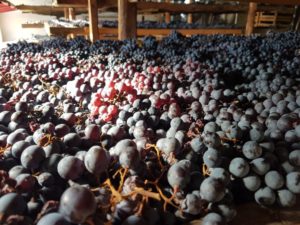
Cantina Mizzon, San Pietro in Cariano (VR): Located in a 1917 farmhouse, in the heart of the Valpolicella Classica area, the Mizzon farm currently belongs to young Nicola Perusi, who’s taken over his grandfather’s company. Its vineyards are found on small estates located in several areas between the valley of Marano di Valpolicella, and the plain of San Pietro in Cariano. Soils are, therefore, very different, ranging from gravelled ones in the lower vineyards to sandy ground in the foothills area and to clayey hills in Valgatara. Several natural techniques have been always applied in order to dramatically reduce the use of pesticides to keep grapes in good health while safeguarding their high quality. Herbicides were completely given up, thus favouring a more balanced environment in the vineyard. Furthermore, the regular defoliation and cleaning procedures allow natural drying and breathing among the grapes, thus reducing the risk of mould and significantly increasing the effectiveness of the cultivation techniques – the latter, using sulfur and copper, are as much natural as possible, that is to say, the vineyards are naturally managed, thoroughly respecting the microfauna and the territory. The grapes for the production of Recioto and Amarone della Valpolicella are left to dry for four months, only with the help of fans and large open windows. The drying process takes place on the traditional “arele”: wood and cane racks, installed in the attic, thus saving a lot of energy. In the basement of the farmhouse, there is the ageing area, or barrel cellar, where the wine rests for months or even years in French oak barrels and barriques.
Distances to other wineries : 2 miles to Cantine Santa Sofia – 4 miles to Cantina Mizzon – 44 miles to Azienda Monte dei Ragni.
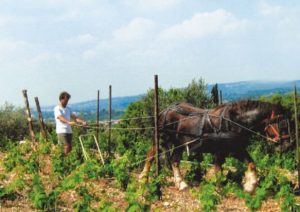
Agricola Monte dei Ragni, località Marega, Fumane (VR): Monte dei Ragni takes its name from a nineteenth-century real estate registry that speaks of a small portion of land on a ridge, in the municipality of Fumane, in the heart of the Valpolicella Classica area. It is only 20-acre wide, with only 5 used as vineyards: still, the latter prove ideal for this purpose, interspersed with several dry stone walls (the “marogne”), with a typical pergola layout that provides perfect insulation and cultivation. Zeno Zignoli cultivates his vineyards with true passion and only one horse for, with dedicated determination and a deep love for the territory; he never uses any chemical or synthetic aids, while thoroughly respecting the local biodiversity. Among the vineyards, olive trees, cereals, fruit trees and vegetables grow as well, enriching the landscape with truly remarkable biodiversity. Wines are eventually put on sale 10 years after the harvest: it’s an enormous effort for such a small winery, but the true value added to utmost respect for wine and consumers. Zignoli does not follow any mere marketing logic: if the season was not that good, he wouldn’t push the vineyard, but rather cultivate something else. The centuries-old plants of the company are entrusted to the care of Stefano Lorenzi, a SIA (Italian Society of Arboriculture) certified arborist and tree-climber SIA, and also a professional sommelier from the AIS (Italian Sommelier Association). Zeno Zignoli is a true icon on Monte dei Ragni. In his 6 acres of vineyards in Marega (Fumane), Valpolicella di Recioto di Ripasso and Amarone grapes are obtained featuring the highest levels of quality and natural, traditional drying. Soft pressing, the wise use of woods for refinement, and an almost total lack of mechanical pumping are the key features of this highly appreciated grape managing process. Only healthy grapes and exceptional wines can be found here, while no more than 6. 000 bottles are usually produced each year.
Distances to other wineries: 44 miles to Cantina Zymè – 45 miles to Cantine Santa Sofia – 45 miles to Cantina Mizzon.
Gardens to visit in the area
Valpolicella is also rich in great gardens, created over time as embellishments to several noble abodes. Our current selection includes only four of them, both ancient and contemporary, English and Italian, but you can find many other gardens in this area, near Lake Garda and in other parts of Veneto by visiting www.italianbotanicalheritage.com,
https://luoghi.italianbotanicaltrips.com/veneto/?category=dimore-ville-castelli-con-giardino
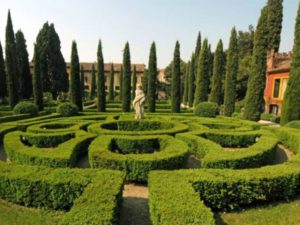
Giardino Giusti, in Verona (VR): The Giusti Gardens are one of the finest examples of a sixteenth-century garden to have survived virtually intact. The gardens masterfully exploit the site and are organised on a long axis that begins at the entrance, which, following the avenue of cypress trees, guides the eye to the focal point of the grotesque stone mask and the belvedere, located on top of a rocky ridge. The level section of the gardens has been designed in the classic style of an Italian garden, while the section that winds up the hill could be described as a prototype of the landscaped style. The elaborate parterres of the level section are decorated with antique statues, while an enclosure on the right houses a labyrinth. The cypress avenue leads to the Cave of Mirrors, an artificial hollow that has been lined with shells, landscape paintings and mirrors that create the illusion of a loggia overlooking the gardens. Further along the foot of the buttresses supporting the hill, there’s a tower with a carved spiral staircase inside; it connects the middle section of the gardens to the upper section, which offers some enchanting views.
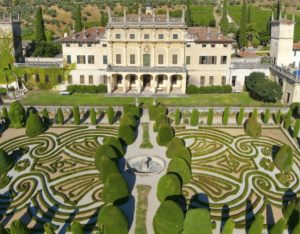
Villa Arvedi, Cuzzano, Grezzana (VR): North of Verona, facing east from a gentle slope and surrounded by a forest of oak trees, Villa Arvedi is remarkable for its monumental magnificence. The current building dates back to the mid-XVII century and makes use of the great stylistic features of the Baroque period. At the rear, an imposing semi-circular containing wall is decorated with niches and topped with an ornate balustrade. The Chapel of San Carlo stands at the end of this view. A backdrop of cypress trees and Lebanon cedars blends into the surrounding olive groves. At the front of the villa, space for a sumptuous garden has been created by regulating the slope of the land with terraces. Enclosed by low walls, the garden’s only function is to provide sophisticated aesthetic enjoyment for the villa. The view to the north is blocked by the main body of the villa that houses a complex of caves; these have been partially hollowed out of the hillside and lined with shells and stalactites. The complex design of the parterre de broderie, with its Baroque curves, dates back to the seventeenth century, in keeping with the taste for French-style gardens, while the large boxwoods of the central axis are some of the rare surviving examples of the original planting.
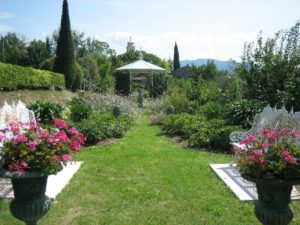
Giardino di Casa Biasi, in Caprino Veronese (VR): The garden of Casa Biasi is the tangible expression of a true passion for plants and flowers: in fact, several generations of its owners have always managed to create something extremely beautiful and evocative, supported by their deep botanical knowledge. The current garden covers a part of the ancient orchard of Villa Boldieri -Trentini and it has been developed by Mario and Luciana Biasi since 1977, on the former vineyard crops – the latter were supposedly abandoned due to very low yield. The relationship between open spaces and the villa, the land features, the exposure, and the evolution of taste have dramatically contributed to the birth of two different areas: the romantic park and the Mediterranean garden. The former has the appearance of a XIX century park, designed around the ancient staircase that descends from the hall through the main floor of the villa: right there, large specimens of lime trees, Lebanon cedars, plane trees, and maples can be found, as well as hellebores, camellias, irises, cyclamens, anemones, hydrangeas, and plantain lilies in the undergrowth. Ferns and perennial herbaceous plants are abundant as well.
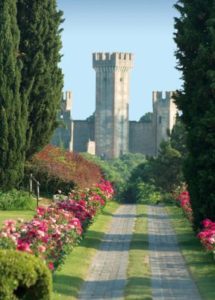
Parco Giardino Sigurtà: Valeggio sul Mincio (VR): in 1978, the park was opened to the public and in 2011 won the First Prize at the Great Italian Gardens competition for the best level of maintenance, good governance and painstaking care of the vegetation. In 2013, was acknowledged as the most beautiful park in Italy in the “private park” category. Today, the Sigurtà Garden Park is considered one of the most extraordinary in the world. The daffodils bloom first in the flowerbeds, followed by tulips, irises, roses, asters, dahlias and many other flowers; water lilies and lotus flowers populate the numerous ponds and pools around the park. Viale delle Rose (“avenue of roses”) is the most iconic feature which has made the Sigurtà Garden Park famous all over the world. It features more than 30.000 carefully selected “Queen Elizabeth” roses, hybrids of Polyantha and Floribunda, blossoming every spring. The new garden maze, featuring 1500 specimens of yew (Taxus baccata), winds through several plants 6.5 ft high and stretches over a rectangular area of 2.989 square yards. Inside the park, there is also a garden of officinal plants with about 40 different species with precious therapeutic properties. In the summer, visitors can enjoy the flowering of aquatic plants. In the 18 basins, diurnal, nocturnal and tropical water lilies bloom with multicoloured corollas, from pink to yellow, and from intense red to cyclamen shades.
Other things to visit in Valpolicella: ancient villas, churches, cherry trees and landscapes

Flowering cherry trees in spring: every year, in March and April, the hills in Valpolicella, Gargagnano and Marano get full of “white clouds” of blossoming cherry trees, typical cultivation of the area. In May their fruits are ripe and many events are usually organized in the nearby villages, with tasting sessions covering all the different varieties cultivated in this area.
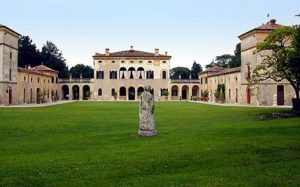
San Pietro in Cariano: this is the very heart of Valpolicella, 12 miles from Lake Garda; it has very ancient origins as per the abundant Roman artefacts and ruins. After the Venetian domination (XV-XVIII centuries), the nobles from Verona built many beautiful villas further embellished with Italian-style gardens. Nowadays, there are about 15 of them left, including Villa Serego, in Santa Sofia di Pedemonte, designed by Andrea Palladio but only partly built. There are also many religious buildings, the most ancient dating back to the Middle Ages, such as San Floriano parish church (in Pieve): the best example of the Romantic style still standing in Valpolicella: it was rebuilt in 1117 after an earthquake that had destroyed the former Longobard building; it now looks like the previous Roman temple.
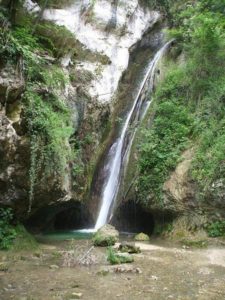
Valle Fumane:
located in a wide plain thickly cultivated with large vineyards, cherry and olive groves, it features many terraces (the “morogne”, in the local dialect) cultivated with vines, woods and lawns. A few streams run deep along the valley (they’re called “progni”) eventually merging into the Fumane stream.
Valle Fumane includes Parco delle Cascate di Molina (Molina Waterfalls Park), a village with paths running among woods and lawns, the Museo Botanico della Lessinia (Lessinia Botanical Museum), the Fiumane Cave (with Neanderthal and Homo Sapiens evidence discovered in 1964), the XVI century Villa della Torre, and Madonna della Salette Sanctuary (standing on the hill which overlooks Fumane and built in 1860 to stop mildew).
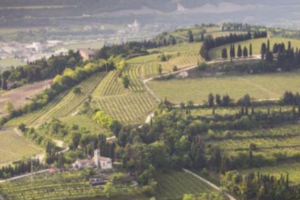
Sant’Ambrogio di Valpolicella: this area has been appreciated for its marble quarries since ancient Roman time. Among the old villas still standing there, we’d recommend the XIV century Villa Serego Alighieri and its beautiful Italian garden. Among the religious buildings, there’s the XII century Chiesetta di San Zeno (Saint Zeno small church) in Poia in Grola, the Longobard-Roman Pieve di San Giorgio.
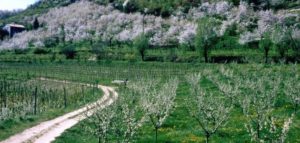
Gargagnago: the Quattro Fontane Path is a pretty evocative attraction, with a 1,5-mile walk originating in the middle of the village and leading to four ancient stone fountains, among fields gloriously covered by cherry trees and vineyards. In spring, visitors shouldn’t miss “Festa della Ciliegia”(Cherry Festival), while in autumn many events are usually organized, including “La Settembrina” in Gargagnago, “Festa de le Fae” (in November), and “Dispensa dei Sapori e dei Saperi” (in December).
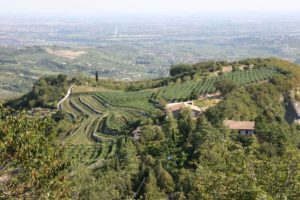
Vallata di Marano: located in Valpolicella Classica, it is rich in prehistoric and historic evidence and it also includes some beautiful villas dating back to the Venetian domination (Villa Lorenzi and Villa Porta in Canzago, Villa Guantieri, and Villa Nuvoloni) and many very interesting churches, such as the XIII century Chiesa di San Marco al Pozzo and its XVI century frescoes, and the XII century Chiesa di Santa Maria in Valverde, built on the remains of a temple dedicated to Minerva; not to mention Chiesa di San Giorgio di Purano, dating back to 1458. This territory is also rich in caves, such as “Coalo del Diavolo” and “Buso Streto” in the Cicalda area, which is also populated by very interesting fauna. It’s wonderful, in spring when cherry trees are in full bloom.
This post is also available in: Italian



Leave a Reply